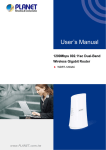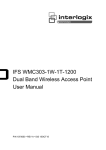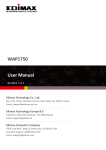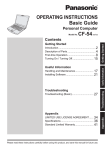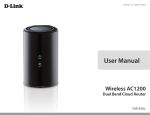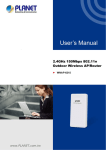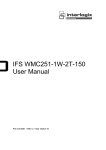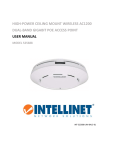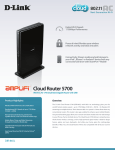Download User`s Manual - PLANET Technology Corporation.
Transcript
Copyright Copyright 2014 by PLANET Technology Corp. All rights reserved. No part of this publication may be reproduced, transmitted, transcribed, stored in a retrieval system, or translated into any language or computer language, in any form or by any means, electronic, mechanical, magnetic, optical, chemical, manual or otherwise, without the prior written permission of PLANET. PLANET makes no representations or warranties, either expressed or implied, with respect to the contents hereof and specifically disclaims any warranties, merchantability or fitness for any particular purpose. Any software described in this manual is sold or licensed "as is". Should the programs prove defective following their purchase, the buyer (and not PLANET, its distributor, or its dealer) assumes the entire cost of all necessary servicing, repair, and any incidental or consequential damages resulting from any defect in the software. Further, PLANET reserves the right to revise this publication and to make changes from time to time in the contents hereof without obligation to notify any person of such revision or changes. All brand and product names mentioned in this manual are trademarks and/or registered trademarks of their respective holders. Federal Communication Commission Interference Statement This equipment has been tested and found to comply with the limits for a Class B digital device, pursuant to Part 15 of FCC Rules. These limits are designed to provide reasonable protection against harmful interference in a residential installation. This equipment generates, uses, and can radiate radio frequency energy and, if not installed and used in accordance with the instructions, may cause harmful interference to radio communications. However, there is no guarantee that interference will not occur in a particular installation. If this equipment does cause harmful interference to radio or television reception, which can be determined by turning the equipment off and on, the user is encouraged to try to correct the interference by one or more of the following measures: 1. Reorient or relocate the receiving antenna. 2. 3. Increase the separation between the equipment and receiver. Connect the equipment into an outlet on a circuit different from that to which the receiver is connected. 4. Consult the dealer or an experienced radio technician for help. FCC Caution To assure continued compliance, use only shielded interface cables when connecting to computer or peripheral devices. Any changes or modifications not expressly approved by the party responsible for compliance could void the user’s authority to operate the equipment. This device complies with Part 15 of the FCC Rules. Operation is subject to the following two conditions: (1) This device may not cause harmful interference (2) This device must accept any interference received, including interference that may cause undesired operation. Any changes or modifications not expressly approved by the party responsible for compliance could void the user’s authority to operate the equipment. I Federal Communication Commission (FCC) Radiation Exposure Statement This equipment complies with FCC radiation exposure set forth for an uncontrolled environment. In order to avoid the possibility of exceeding the FCC radio frequency exposure limits, human proximity to the antenna shall not be less than 20 cm (8 inches) during normal operation. R&TTE Compliance Statement This equipment complies with all the requirements of DIRECTIVE 1999/5/CE OF THE EUROPEAN PARLIAMENT AND THE COUNCIL OF 9 March 1999 on radio equipment and telecommunication terminal equipment and the mutual recognition of their conformity (R&TTE). The R&TTE Directive repeals and replaces in the directive 98/13/EEC (Telecommunications Terminal Equipment and Satellite Earth Station Equipment) as of April 8, 2000. Safety This equipment is designed with the utmost care for the safety of those who install and use it. However, special attention must be paid to the dangers of electric shock and static electricity when working with electrical equipment. All guidelines of this and of the computer manufacture must therefore be allowed at all times to ensure the safe use of the equipment. National Restrictions This device is intended for home and office use in all EU countries (and other countries following the EU directive 1999/5/EC) without any limitation except for the countries mentioned below: Country Restriction Bulgaria None France Reasons/remarks General authorization required for outdoor use and public service Outdoor use; limited to 10 Military Radiolocation use. Refarming of the 2.4 GHz mW e.i.r.p. within the band band has been ongoing in recent years to allow current 2454-2483.5 MHz relaxed regulation. Full implementation planned 2012 Italy None Luxembourg None Norway Implemented Russian None If used outside of own premises, general authorization is required General authorization required for network and service supply(not for spectrum) This subsection does not apply for the geographical area within a radius of 20 km from the centre of Ny-Ålesund Only for indoor applications Federation Note: Please don’t use the product outdoors in France. WEEE regulation To avoid the potential effects on the environment and human health as a result of the presence of hazardous substances in electrical and electronic equipment, end users of electrical and electronic equipment should understand the meaning of the crossed-out wheeled bin symbol. Do not dispose of WEEE as unsorted municipal waste and have to collect such WEEE separately. II Revision User Manual of PLANET 1750Mbps 802.11ac Dual Band Wall Mount Wireless Access Point Model: WDAP-1750AC Rev: 1.0 (Nov., 2014) Part No. EM-WDAP-1750AC_v1.0 (2081-E11030-000) III CONTENTS Chapter 1.Product Introduction........................................................................................................... 1 1.1 Package Contents ............................................................................................................... 1 1.2 Product Description............................................................................................................ 2 1.3 Product Features................................................................................................................. 7 1.4 Product Specifications ....................................................................................................... 8 Chapter 2.Hardware Installation ........................................................................................................12 2.1 Product Outlook ................................................................................................................12 2.1.1 Panel Layout...........................................................................................................13 2.1.2 Hardware Description .............................................................................................13 Chapter 3.Connecting to the AP ........................................................................................................15 3.1 System Requirements ......................................................................................................15 3.2 Installing the AP ................................................................................................................15 Chapter 4.Quick Installation Guide ...................................................................................................18 4.1 Manual Network Setup - TCP/IP Configuration ..............................................................18 4.1.1 Configuring the IP Address Manually .....................................................................18 4.2 Starting Setup in the Web UI ............................................................................................21 4.3 Basic Settings ...................................................................................................................22 4.3.1 LAN IP Address ......................................................................................................22 4.3.2 2.4GHz & 5GHz SSID & Security ...........................................................................23 4.3.3 Administrator Name & Password............................................................................23 4.3.4 Time & Date ............................................................................................................24 Chapter 5.Configuring the AP............................................................................................................25 5.1 5.2 5.3 Information ........................................................................................................................25 5.1.1 System Information.................................................................................................25 5.1.2 Wireless Clients ......................................................................................................27 5.1.3 Wireless Monitor .....................................................................................................28 5.1.4 Log ..........................................................................................................................29 Networking Settings .........................................................................................................30 5.2.1 LAN-side IP Address...............................................................................................30 5.2.2 LAN Port .................................................................................................................31 5.2.3 VLAN.......................................................................................................................32 Wireless Settings ..............................................................................................................33 5.3.1 2.4GHz 11bgn Basic Settings .................................................................................33 5.3.2 Advanced................................................................................................................35 5.3.3 Security ...................................................................................................................36 5.3.4 WDS........................................................................................................................40 IV 5.3.5 5GHz 11ac 11an Basic Settings .............................................................................42 5.3.6 Advanced................................................................................................................43 5.3.7 Security ...................................................................................................................44 5.3.8 WDS........................................................................................................................49 5.3.9 WPS........................................................................................................................51 5.3.10 RADIUS Settings ....................................................................................................52 5.3.11 Internal Server ........................................................................................................53 5.3.12 RADIUS Accounts...................................................................................................54 5.3.13 MAC Filter...............................................................................................................55 5.3.14 WMM.......................................................................................................................56 5.4 5.5 Management ......................................................................................................................58 5.4.1 Admin......................................................................................................................58 5.4.2 Date and Time ........................................................................................................60 5.4.3 Syslog Server .........................................................................................................60 5.4.4 I’m Here ..................................................................................................................61 Advanced ...........................................................................................................................62 5.5.1 LED Settings...........................................................................................................62 5.5.2 Update Firmware ....................................................................................................62 5.5.3 Save/Restore Settings ............................................................................................63 5.5.4 Factory Default .......................................................................................................64 5.5.5 Reboot ....................................................................................................................64 Chapter 6.Quick Connection to a Wireless Network .......................................................................65 6.1 Windows XP (Wireless Zero Configuration) ...................................................................65 6.2 Windows 7 (WLAN AutoConfig).......................................................................................67 6.3 Mac OS X 10.x....................................................................................................................70 6.4 iPhone / iPod Touch / iPad ...............................................................................................74 Appendix A: Planet Smart Discovery Utility.....................................................................................77 Appendix B: Troubleshooting............................................................................................................78 Appendix C: Glossary.........................................................................................................................80 V FIGURES FIGURE 2-1 WDAP-1750AC ...................................................................................................................12 FIGURE 2-2 WDAP-1750AC PANEL LAYOUT ............................................................................................13 FIGURE 3-1 WDAP-1750AC INSTALLATION DIAGRAM 1 ............................................................................15 FIGURE 3-2 WDAP-1750AC INSTALLATION DIAGRAM 2 ............................................................................16 FIGURE 3-3 WDAP-1750AC INSTALLATION DIAGRAM 3 ............................................................................17 FIGURE 4-1 TCP/IP SETTING ...................................................................................................................19 FIGURE 4-2 WINDOWS START MENU ........................................................................................................19 FIGURE 4-3 SUCCESSFUL RESULT OF PING COMMAND ...............................................................................20 FIGURE 4-4 FAILED RESULT OF PING COMMAND .......................................................................................20 FIGURE 4-5 LOGIN BY DEFAULT IP ADDRESS ..............................................................................................21 FIGURE 4-6 LOGIN WINDOW.....................................................................................................................21 FIGURE 4-7 BASIC SETTINGS - DHCP ......................................................................................................22 FIGURE 4-8 BASIC SETTINGS - WIRELESS SETTINGS .................................................................................23 FIGURE 4-9 BASIC SETTINGS - ADMINISTRATOR SETTING ...........................................................................23 FIGURE 4-10 BASIC SETTINGS - TIME & DATE ...........................................................................................24 FIGURE 5-1 INFORMATION - MAIN MENU ...................................................................................................25 FIGURE 5-2 INFORMATION - WIRELESS CLIENTS ........................................................................................27 FIGURE 5-3 INFORMATION - WIRELESS MONITOR ......................................................................................28 FIGURE 5-4 INFORMATION - LOG...............................................................................................................29 FIGURE 5-5 NETWORK SETTINGS - LAN-SIDE IP ADDRESS ........................................................................30 FIGURE 5-6 NETWORK SETTINGS - LAN PORT ..........................................................................................31 FIGURE 5-7 NETWORK SETTINGS - VLAN.................................................................................................32 FIGURE 5-8 2.4GHZ WIRELESS SETTINGS ................................................................................................33 FIGURE 5-9 2.4GHZ WIRELESS SETTINGS - ADVANCED.............................................................................35 FIGURE 5-10 2.4GHZ WIRELESS SETTINGS - SECURITY ............................................................................36 FIGURE 5-11 2.4GHZ WIRELESS SETTINGS - WEP...................................................................................37 FIGURE 5-12 2.4GHZ WIRELESS SETTINGS - IEEE802.1X/EAP ...............................................................38 FIGURE 5-13 2.4GHZ WIRELESS SETTINGS - WPA-PSK ..........................................................................38 FIGURE 5-14 2.4GHZ WIRELESS SETTINGS - WPA-EAP ..........................................................................39 FIGURE 5-15 2.4GHZ WIRELESS SETTINGS - WDS ..................................................................................41 FIGURE 5-16 5GHZ WIRELESS SETTINGS .................................................................................................42 FIGURE 5-17 5GHZ WIRELESS SETTINGS - ADVANCED..............................................................................44 FIGURE 5-18 5GHZ WIRELESS SETTINGS - SECURITY ...............................................................................45 FIGURE 5-19 5GHZ WIRELESS SETTINGS - WEP......................................................................................46 FIGURE 5-20 5GHZ WIRELESS SETTINGS - IEEE802.1X/EAP ..................................................................47 FIGURE 5-21 5GHZ WIRELESS SETTINGS - WPA-PSK .............................................................................47 FIGURE 5-22 5GHZ WIRELESS SETTINGS - WPA-EAP .............................................................................48 FIGURE 5-23 5GHZ WIRELESS SETTINGS - WDS .....................................................................................50 FIGURE 5-24 WPS ..................................................................................................................................51 FIGURE 5-25 RADIUS SETTINGS .............................................................................................................52 FIGURE 5-26 INTERNAL SERVER...............................................................................................................53 FIGURE 5-27 RADIUS ACCOUNTS ...........................................................................................................54 VI FIGURE 5-28 MAC FILTER .......................................................................................................................55 FIGURE 5-29 WMM.................................................................................................................................56 FIGURE 5-30 ADMIN.................................................................................................................................58 FIGURE 5-31 TIME AND DATE ...................................................................................................................60 FIGURE 5-32 SYSLOG SERVER.................................................................................................................61 FIGURE 5-33 I’M HERE.............................................................................................................................61 FIGURE 5-34 LED SETTINGS ...................................................................................................................62 FIGURE 5-35 UPDATE FIRMWARE .............................................................................................................62 FIGURE 5-36 SAVE/RESTORE SETTINGS ...................................................................................................63 FIGURE 5-37 FACTORY DEFAULT ..............................................................................................................64 FIGURE 5-38 REBOOT .............................................................................................................................64 FIGURE 6-1 SYSTEM TRAY – WIRELESS NETWORK ICON ...........................................................................65 FIGURE 6-2 CHOOSE A WIRELESS NETWORK .............................................................................................65 FIGURE 6-3 ENTER THE NETWORK KEY .....................................................................................................66 FIGURE 6-4 CHOOSE A WIRELESS NETWORK -- CONNECTED ......................................................................66 FIGURE 6-5 NETWORK ICON .....................................................................................................................67 FIGURE 6-6 WLAN AUTOCONFIG .............................................................................................................67 FIGURE 6-7 TYPE THE NETWORK KEY .......................................................................................................68 FIGURE 6-8 CONNECTING TO A NETWORK .................................................................................................68 FIGURE 6-9 CONNECTED TO A NETWORK ..................................................................................................69 FIGURE 6-10 MAC OS – NETWORK ICON ..................................................................................................70 FIGURE 6-11 HIGHLIGHT AND SELECT THE WIRELESS NETWORK .................................................................70 FIGURE 6-12 ENTER THE PASSWORD .......................................................................................................71 FIGURE 6-13 CONNECTED TO THE NETWORK ............................................................................................71 FIGURE 6-14 SYSTEM PREFERENCES .......................................................................................................72 FIGURE 6-15 SYSTEM PREFERENCES -- NETWORK ...................................................................................72 FIGURE 6-16 SELECT THE WIRELESS NETWORK .......................................................................................73 FIGURE 6-17 IPHONE – SETTINGS ICON ....................................................................................................74 FIGURE 6-18 WI-FI SETTING ....................................................................................................................74 FIGURE 6-19 WI-FI SETTING – NOT CONNECTED ......................................................................................75 FIGURE 6-20 TURN ON WI-FI ...................................................................................................................75 FIGURE 6-21 IPHONE -- ENTER THE PASSWORD ........................................................................................76 FIGURE 6-22 IPHONE -- CONNECTED TO THE NETWORK ............................................................................76 VII User Manual of WDAP-1750AC Chapter 1. Product Introduction 1.1 Package Contents Thank you for choosing PLANET WDAP-1750AC. Before installing the AP, please verify the contents inside the package box. WDAP-1750AC Quick Guide Antenna x 3 Wall-mount Strip x 2 Screws Power Adapter If there is any item missing or damaged, please contact the seller immediately. -1- User Manual of WDAP-1750AC 1.2 Product Description Ultra-high-speed, Next-generation Enterprise Wireless PLANET WDAP-1750AC is an enterprise PoE access point with the latest 802.11ac wireless technology, advanced management features and superior encryption standard yet cost-effective. Meeting enterprise demand, the WDAP-1750AC has enhanced security and management features including multiple SSIDs, IEEE 802.1Q VLAN, WPA / WPA2-enterprise security, RADIUS MAC authentication and so forth. With the multiple reversed-polarity SMA male antenna connectors, the WDAP-1750AC is able to connect its suitable external antenna and booster wirelessly. Extraordinary 11ac Dual Band Wireless Technology The WDAP-1750AC supports IEEE 802.11a/b/g/n/ac dual band standards with 3T3R MIMO technology; therefore, it provides the wireless speed up to 450+1300Mbps, which is 24X faster than the 11a access point at 5GHz frequency and 8X faster than the 11g access point at 2.4GHz frequency. The incredible wireless speed makes it ideal for handling multiple HD movie streams, high-resolution on-line games, stereo music, VoIPs and data streams at the same time stably and smoothly. -2- User Manual of WDAP-1750AC Secured and Managed Enterprise-class WLAN With support for high-level encryption mechanism, the WDAP-1750AC can effectively prevent your information from eavesdropping by unauthorized users. Allowing multiple different SSIDs to be used simultaneously and cooperating with the VLAN support, the WDAP-1750AC helps network administrators define separate wireless subnets for various class-of-service and security policies. 11ac Innovations Bring Excellent Data Link Speed The WDAP-1750AC has 3 detachable highly-sensitive antennas which provide stronger signal and excellent coverage even in the wide-ranging or bad environment. With adjustable transmit power option, the administrator can flexibly reduce or increase the output power for various environments, thus reducing interference to achieve maximum performance. To provide extremely high-speed user experience, the WDAP-1750AC adopts IEEE 802.11ac technology to extend the 802.11n 40MHz channel binding to 80MHz and the implementation of 256-QAM modulation where higher transmitting/receiving rates go up to 1300Mbps in 5GHz less interference frequency band. In addition, the WDAP-1750AC is equipped with Gigabit LAN port to eliminate the restriction of 100Mbps Fast Ethernet wired connection to let users fully enjoy the high speed provided by wireless. The IEEE 802.11ac also optimizes MU-MIMO (Multi-User MIMO) mechanism to serve multiple devices simultaneously. Multiple Operation Modes for Various Applications The WDAP-1750AC supports AP, WDS Bridge, and Repeater modes, through which it provides more flexibility for users when wireless network is established. Compared with general wireless access point, the WDAP-1750AC offers more powerful and flexible capability for wireless clients. -3- User Manual of WDAP-1750AC Wireless Security Encryption and Wireless Value-added Features In aspect of security, besides 64/128-bit WEP encryption, the WDAP-1750AC is integrated with WPA / WPA2, WPA-PSK / WPA2-PSK and 802.1x Radius authority to secure and protect your wireless LAN. It provides the wireless MAC filtering and SSID broadcast control to consolidate the wireless network security and prevent unauthorized wireless connection. Being an access point, the WDAP-1750AC supports the VLAN function to allow multiple SSIDs (32 sets of SSIDs) to access Internal VLAN topology. Moreover, its Wi-Fi Multimedia (WMM) mechanism provides enhanced QoS over wireless connection for better performance in multimedia transmission like on-line gaming and video streaming, which are classified as a top priority. -4- User Manual of WDAP-1750AC Extreme High Speed and Dual Band Make Wi-Fi transmission More Powerful The WDAP-1750AC delivers the dual band technology to avoid signal interference and ensure the best Wi-Fi performance. It allows you to check e-mail and surf the Internet via the 2.4GHz band and simultaneously watch high-definition (HD) video or any other multimedia application via 5GHz band. Moreover, the Gigabit Ethernet port of the WDAP-1750AC offers ultra-fast wired connections that utilize the maximum wireless bandwidth; therefore, users will have real wireless speed over 100Mbps. With outstanding stability of high-speed wireless transmission, the WDAP-1750AC can provide users with excellent experience in multimedia streaming with your mobile devices anywhere, anytime. Wall-mount Design Perfect for Room Installation The WDAP-1750AC is adopted with the latest 802.11ac technology to provide extreme high-speed wireless experience for users. With the stylish wall-mount design, you don’t need to spend extra time and cost to deploy the wireless network. Its sleek and fashionable appearance adapted to the room can match any decor without affecting the original interior design. Furthermore, the WDAP-1750AC supports standard 802.3at PoE power scheme, effectively reducing the cabling cost. The WDAP-1750AC, with the SNMP supported, brings the most convenience to system administrators or machine operators. No expensive instruments or complex back-end subscriber managed systems are required for deployment. Flexible Deployment with PoE Feature Compliant with the IEEE 802.3at Power over Ethernet standard, the WDAP-1750AC can be powered and networked by a single UTP cable. It thus reduces the needs of extra cables and dedicated electrical outlets on -5- User Manual of WDAP-1750AC the wall, ceiling or any other place where it is difficult to reach. The wireless network deployment becomes more flexible and worry-free from the power outlet locations. As it is a highly-reliable industrial wall-mount design, the WDAP-1750AC can be firmly installed on the wall conveniently. Easy Installation and Management With user-friendly Web UI, the WDAP-1750AC is easy to install, even for users who never experience setting up a wireless network. Furthermore, with SNMP-based management interface, the WDAP-1750AC is convenient to be managed and configured remotely in a small business wireless network. -6- User Manual of WDAP-1750AC 1.3 Product Features Standard Compliant Hardware Interface Complies with IEEE 802.11ac (draft 2.0) and IEEE 802.11a/b/g/n standards 2 x 10/100/1000BASE-TX port with PoE supporting 802.3at and 802.3af PSE (Power Sourcing Equipment). IEEE standard 802.3af/at PoE design RF Interface Characteristics Features 2.4GHz (802.11b/g/n) and 5GHz (802.11a/n/ac) concurrent dual band for more efficiency of carrying high load traffic 3T3R MIMO technology for enhanced throughput and coverage Provides multiple adjustable transmit power control High speed up to 1.75Gbps (450Mbps for 2.4GHz + 1300Mbps for 5GHz) wireless data rate Comprehensive Wireless Advanced Features Multiple Wireless Modes: AP,WDS PtP/ PtMP, and WDS Repeater Supports up to 32 multiple-SSIDs (2.4GHz + 5GHz) to allow users to access different networks through a single AP Supports VLAN function to limit the clients to access the specific internal network resource Supports WMM (Wi-Fi Multimedia) and wireless QoS to enhance the efficiency of multimedia application Supports wireless schedule to automatically enable or disable the wireless function based on predefined schedule. *Future firmware supports Secure Network Connection Advanced security: 64/128-bit WEP, WPA / WPA2, WPA-PSK / WPA2-PSK (TKIP/AES encryption) and 802.1x Radius Authentication Supports MAC address Filtering Easy Installation & Management Flexible Deployment with Standard 802.3at PoE/ PD supported Web-based configuration of HTTP/HTTPS/SSH/CLI SNMP-based management interface System status monitoring includes DHCP Client, System Log -7- User Manual of WDAP-1750AC 1.4 Product Specifications Product WDAP-1750AC Hardware Specifications LAN 1 (PoE In) Interfaces Antennas Button / Switch LED Indicators LAN 2 (PoE Out) 10/100/1000BASE-T Auto MDI/MDI-X RJ45 port with 802.3af PoE injector USB USB port for system log and system configuration file Console 1 x RS-232-to-RJ45 serial port (115200, 8, N, 1) Gain 3 x 2dBi RP-SMA (Male) dual-band antenna Reset Press over 5 seconds to reset the device to factory default WPS Press for 1~2 seconds to activate WPS function Eject Eject an attached USB device Switch Power ON/Off switch PWR Allow LED to turn off via software control Material Plastic Dimensions (WxDxH) 182 x 182 x 30mm Weight 470g Power Requirements 10/100/1000BASE-T Auto MDI/MDI-X RJ45 port DC Input: 12V DC, 4A PoE Input: IEEE 802.3at PoE+, 48~56V DC in-line power ESD Protection ±8kV air-gap discharge, ±4kV contact discharge Mounting Wall mount / Desktop Wireless Interface Specifications IEEE 802.11ac (draft 2.0) 5GHz Standard IEEE 802.11a/n 5GHz IEEE 802.11b/g/n 2.4GHz Antenna Structure Modulation 802.11ac: 3T3R MU-MIMO 802.11n: 3T3R MIMO DSSS 802.11ac: OFDM (BPSK / QPSK / 16QAM / 64QAM / 256QAM) Data Modulation 802.11a/g/n: OFDM (BPSK / QPSK / 16QAM / 64QAM) 802.11b: DSSS (DBPSK / DQPSK / CCK) Band Mode 2.4G / 5G concurrent mode 2.4GHz Frequency Range 5GHz 2.4GHz Operating Channels America/ FCC: 2.412~2.462GHz Europe/ ETSI: 2.412~2.484GHz America/ FCC: 5.180~5.240GHz, 5.725~5.850GHz Europe/ ETSI: 5.180~5.240GHz America/ FCC: 1~11 Europe/ ETSI: 1~13 America/ FCC: 5GHz 36, 40, 44, 48, 149, 153, 157, 161, 165 Europe/ ETSI: -8- User Manual of WDAP-1750AC 36, 40, 44, 48 5GHz channel list will vary in different countries according to their regulations. Channel Width 802.11ac: 20/40/80MHz 802.11n: 20/40MHz 802.11ac (draft): up to 30m 802.11n: up to 70m Transmission Distance 802.11g: up to 30m The estimated transmission distance is based on the theory. The actual distance will vary in different environments. 5GHz: 802.11a 2.4GHz: 802.11b 22dBm@6Mbps 23dBm@1Mbps 22dBm@9Mbps 23dBm@2Mbps 22dBm@12Mbps [email protected] 22dBm@18Mbps 23dBm@11Mbps 22dBm@24Mbps 802.11g 21dBm@36Mbps 23dBm@6Mbps 19dBm@48Mbps 23dBm@9Mbps 18dBm@54Mbp 23dBm@12Mbps 802.11an(5G) Max. RF Power 23dBm@18Mbps 27.5dBm@MCS0/8/16 23dBm@24Mbps 26.5dBm@MCS1/9/17 22dBm@36Mbps 26.5dBm@MCS2/10/18 20dBm@48Mbps 25.5dBm@MCS3/11/19 19dBm@54Mbps 25.5dBm@MCS4/12/20 802.11gn (2.4G) 24.5dBm@MCS5/13/21 27.5dBm@MCS0/8/16 23.5dBm@MCS6/14/22 26.5dBm@MCS1/9/17 22.5dBm@MCS7/15/23 26.5dBm@MCS2/10/18 802.11ac 26.5dBm@MCS3/11/19 27.5dBm@MCS0 25.5dBm@MCS4/12/20 26.5dBm@MCS1 24.5dBm@MCS5/13/21 26.5dBm@MCS2 23.5dBm@MCS6/14/22 25.5dBm@MCS3 22.5dBm@MCS7/15/23 25.5dBm@MCS4 24.5dBm@MCS5 23.5dBm@MCS6 22.5dBm@MCS7 20.5dBm@MCS8 19.5dBm@MCS9 5GHz: 802.11a: -71dBm @ 54Mbps Receive Sensitivity 802.11n (HT20): -87dBm @ MCS0, -67dBm @ MCS7 802.11n (HT40): -84dBm @ MCS0, -63dBm @ MCS7 -9802.11ac (VHT20): -64dBm @ MCS9 User Manual of WDAP-1750AC 802.11ac (VHT40): -61dBm @ MCS9 802.11ac (VHT80): -58dBm @ MCS9 2.4GHz: 802.11b: -90dBm @1Mbps 802.11g: -70dBm @54Mbps 802.11n (HT20/40): -87dBm @MCS0 802.11n (HT20/40): -67dBm @MCS7 Software Features Wireless Mode Encryption Security AP (Access Point) WDS PTP (Point to Point) Repeater (WDS + AP) WDS PTMP (Point to Multipoint) WEP (64/128-bit) encryption security WPA / WPA2 (TKIP/AES) WPA-PSK / WPA2-PSK (TKIP/AES) 802.1x Authenticator (MD5/TLS/TTLS/PEAP/EAP-FAST, EAP-SIM/MAC Authentication) Wireless MAC address filtering, up to 256 entries Wireless Security Supports WPS (Wi-Fi Protected Setup) Enable/ Disable SSID Broadcast WMM (Wi-Fi Multimedia), Max. Associated Station Number Multiple SSIDs: up to 16 at 2.4GHz and 16 at 5GHz Wireless Isolation: Enable it to isolate each connected wireless client Wireless Advanced from communicating with each other WLAN L2 isolation (AP mode) Provides wireless statistics Tx power control adjustment by %: 10%, 25%, 50%, 75%, 90%, 100% Auto-channel: Automatically selecting lease congested channel Wired: 253 Max. Clients 2.4GHz Wireless: 50 5GHz Wireless: 50 Built-in DHCP server supporting static IP address distribution LAN Supports UPnP Supports 802.1Q VLAN, SSID and Ethernet port-based tag/untag VID from 1~4094 Web-based (HTTP/HTTPS) management interface SNMP v1,v2c,v3 SNTP synchronization System Management Firmware upgrade via WEB, USB and FTP Supports scheduling reboot Supports Smart Discovery Utility* Local RADIUS: Radius server built-in with 256 accounts support -10- User Manual of WDAP-1750AC Standards Conformance IEEE 802.11ac (draft 2.0, 3T3R, up to 1300Mbps) IEEE 802.11n (3T3R, up to 450Mbps) IEEE 802.11g IEEE 802.11b IEEE Standards IEEE 802.11i IEEE 802.3 10BASE-T IEEE 802.3u 100BASE-TX IEEE 802.3ab 1000BASE-T IEEE 802.3x Flow Control IEEE 802.11 MIB SNMP MIBs IEEE 802.1AE LLDP-MIB Bridge MIB Interface MIB Other Protocols and Standards CSMA/CA, CSMA/CD, TCP/IP, DHCP, ICMP, SNTP Environment & Certification Temperature Humidity Regulatory Operating: 0 ~ 50 degrees C Storage: -20 ~ 60 degrees C Operating: 10 ~ 90% (non-condensing) Storage: 5 ~ 90% (non-condensing) FCC, CE -11- User Manual of WDAP-1750AC Chapter 2. Hardware Installation Please follow the instructions below to connect WDAP-1750AC to the existing network devices and your computers. 2.1 Product Outlook Dimensions: (W x D x H) 182 x 30 x 182 mm Weight : 470g Figure 2-1 WDAP-1750AC -12- User Manual of WDAP-1750AC 2.1.1 Panel Layout Figure 2-2 shows the hardware interface of the WDAP-1750AC. Hardware Interface Figure 2-2 WDAP-1750AC Panel Layout 2.1.2 Hardware Description Port definition Object 12V DC LAN1 (PoE In) LAN2 (PoE Out) Description 12V DC port to connect the power adapter LAN port with IEEE 802.3at Power over Ethernet (PoE) to power on the device. LAN port with IEEE 802.3af Power over Ethernet (PoE) OUT to supply power to the POE IP-CAM. USB USB Port for system log Eject Eject an attached USB device Console Reset WPS Power On/Off Connect a management console To restore to the factory default setting, press and hold the Reset Button over 7 seconds, and then release it. Wi-Fi Protected Setup (WPS) button Switch the access point on/off -13- User Manual of WDAP-1750AC LED definition LED STATUS FUNCTION Off The access point is off. Blue The access point is on. Amber The access point is starting up. Flashing Amber The access point cannot establish a connection to the network. Flashing Amber and Blue The access point is experiencing a problem of starting up. The access point will restart. -14- User Manual of WDAP-1750AC Chapter 3. Connecting to the AP 3.1 System Requirements Broadband Internet Access Service (Cable/xDSL/Ethernet connection) One IEEE 802.3at PoE switch (supply power to the WDAP-1750AC) PCs with a working Ethernet Adapter and an Ethernet cable with RJ45 connectors PCs running Windows 98/ME, NT4.0, 2000/XP, Windows Vista / Win 7, MAC OS 9 or later, Linux, UNIX or other platforms are compatible with TCP/IP protocols 1. The AP in the following instructions refers to PLANET WDAP-1750AC. 2. It is recommended to use Internet Explore 7.0 or above to access the AP. 3.2 Installing the AP Before installing the AP, make sure your PoE switch is connected to the Internet through the broadband service successfully at this moment. If there is any problem, please contact your local ISP. After that, please install the AP according to the following steps. Don't forget to pull out the power plug and keep your hands dry. Step 1. Attach the two magnetic wall-mount strips to your wall using the included screws, as shown below.. Figure 3-1 WDAP-1750AC Installation Diagram 1 -15- User Manual of WDAP-1750AC Step 2. Fasten the antennas to the antenna connectors. And you can bend the antennas to fit your actual needs. Figure 3-2 WDAP-1750AC Installation Diagram 2 Step 3. Method A - Power socket nearby Connect he power adapter to the access point’s 12V DC port and plug the power adapter into a power source. Method B – Hard to find the power socket Plug the RJ45 Ethernet cable into the PoE port of the WDAP-1750AC and the other end of Ethernet cable into the PoE switch. Method A - Power socket nearby -16- User Manual of WDAP-1750AC Method B - Hard to find the power socket Figure 3-3 WDAP-1750AC Installation Diagram 3 -17- User Manual of WDAP-1750AC Chapter 4. Quick Installation Guide This chapter will show you how to configure the basic functions of your AP within minutes. A computer with wired Ethernet connection to the Wireless AP is required for the first-time configuration. 4.1 Manual Network Setup - TCP/IP Configuration The default IP address of the WDAP-1750AC is 192.168.1.253. And the default Subnet Mask is 255.255.255.0. These values can be changed as you want. In this guide, we use all the default values for description. Connect the WDAP-1750AC with your PC by an Ethernet cable plugging in LAN port on one side and in LAN port of PC on the other side. Please power on the WDAP-1750AC by PoE switch through the PoE port. In the following sections, we’ll introduce how to install and configure the TCP/IP correctly in Windows 7. And the procedures in other operating systems are similar. First, make sure your Ethernet Adapter is working, and refer to the Ethernet adapter manual if needed. 4.1.1 Configuring the IP Address Manually Summary: Set up the TCP/IP Protocol for your PC. Configure the network parameters. The IP address is 192.168.1.xxx (if the default IP address of the WDAP-1750AC is 192.168.1.253, and the DSL router is 192.168.1.254, the "xxx" can be configured to any number from 1 to 252), Subnet Mask is 255.255.255.0. 1 Select Use the following IP address radio button, and then configure the IP address of the PC. 2 For example, as the default IP address of the WDAP-1750AC is 192.168.1.253 and the DSL router is 192.168.1.254, you may choose from 192.168.1.1 to 192.168.1.252. -18- User Manual of WDAP-1750AC Figure 4-1 TCP/IP Setting Now click OK to save your settings. Now, you can run the ping command in the command prompt to verify the network connection between your PC and the AP. The following example is in Windows 7 OS. Please follow the steps below: 1. Click on Start > Run. 2. Type “cmd” in the Search box. Figure 4-2 Windows Start Menu -19- User Manual of WDAP-1750AC 3. Open a command prompt, type ping 192.168.1.253 and then press Enter. If the result displayed is similar to Figure 4-3, it means the connection between your PC and the AP has been established well. Figure 4-3 Successful Result of Ping Command If the result displayed is similar to Figure 4-4, it means the connection between your PC and the AP has failed. Figure 4-4 Failed Result of Ping Command If the address is 0.0.0.0, check your adapter installation, security settings, and the settings on your AP. Some firewall software programs may block a DHCP request on newly installed adapters. -20- User Manual of WDAP-1750AC 4.2 Starting Setup in the Web UI It is easy to configure and manage the AP with the web browser. Step 1. To access the configuration utility, open a web-browser and enter the default IP address http://192.168.1.253 in the web address field of the browser. Figure 4-5 Login by default IP address After a moment, a login window will appear. Enter admin for the User Name and Password, both in lower case letters. Then click the OK button or press the Enter key. Figure 4-6 Login Window Default IP Address: 192.168.1.253 Default User name: admin Default Password: admin If the above screen does not pop up, it may mean that your web-browser has been set to a proxy. Go to Tools menu>Internet Options>Connections>LAN Settings on the screen that appears, cancel the Using Proxy checkbox, and click OK to finish it. -21- User Manual of WDAP-1750AC 4.3 Basic Settings The instructions below will help you to configure the following basic settings of the access point: LAN IP Address 2.4GHz & 5GHz SSID & Security Administrator Name & Password Time & Date It is recommended you configure these settings before using Planet WDAP-1750AC. 4.3.1 LAN IP Address 1. To change the access point’s LAN IP address, go to “Network Settings” > “LAN-side IP Address” and you will see the screen below. Figure 4-7 Basic Settings - DHCP 2. Enter the IP address settings you want to use for your access point. You can use a dynamic (DHCP) or static IP address, depending on your network environment. Click “Apply” to save the changes and wait a few moments for the access point to reload. When you change your access point’s IP address, you need to use the new IP address to access the browser based configuration interface instead of the default IP 192.168.1.253. -22- User Manual of WDAP-1750AC 4.3.2 2.4GHz & 5GHz SSID & Security 1. To change the SSID of your WDAP-1750AC’s 2.4GHz wireless network(s), go to “Wireless Setting” > “2.4GHz 11bgn” > “Basic”. Enter the new SSID for your 2.4GHz wireless network in the “SSID1” field and click “Apply”. Figure 4-8 Basic Settings - Wireless settings 2. Go to “Wireless Setting” > “5GHz 11ac 11an” and repeat steps1 for the access point’s 5GHz wireless network. 4.3.3 Administrator Name & Password 1. To change the administrator name and password for the browser based configuration interface, go to “Management” > “Admin”. Figure 4-9 Basic Settings - Administrator setting 2. Complete the “Administrator Name” and “Administrator Password” fields and click “Apply”. -23- User Manual of WDAP-1750AC 4.3.4 Time & Date 1. To set the correct time for your access point, go to “Management” > “Date and Time”. Figure 4-10 Basic Settings - Time & Date 2. Set the correct time and time zone for your access point using the drop down menus. The access point also supports NTP (Network Time Protocol) so alternatively you can enter the host name or IP address of a time server. Click “Apply” when you are finished. You can also use the “Acquire Current Time from your PC” button if you wish to set the access point to the same time as your PC. -24- User Manual of WDAP-1750AC Chapter 5. Configuring the AP This chapter delivers a detailed presentation of AP’s functionalities and features under 5 main menus below, allowing you to manage the AP with ease. 5.1 Information 5.1.1 System Information The “System Information” page displays basic system information about the access point. Figure 5-1 Information - Main Menu The page includes the following information: Object Description Model Displays the model number of the access point. Product Name Displays the product name for reference, which consists of “AP” plus the MAC address. Uptime Displays the total time since the device was turned on. Boot From Displays information for the booted hardware, booted from either USB or internal memory. MAC Address Displays the access point’s MAC address. Management VLAN ID Displays the management VLAN ID. Runtime Code Version Displays the runtime code version. IP Address Displays the IP address of this device. Click “Refresh” to update this -25- User Manual of WDAP-1750AC value. Default Gateway Displays the IP address of the default gateway. DNS IP address of DNS (Domain Name Server) DHCP Server IP address of DHCP Server. Wired LAN Port Specifies which LAN port (1 or 2). Status Displays the status of the specified LAN port (connected or disconnected). VLAN Mode/ID Displays the VLAN mode (tagged or untagged) and VLAN ID for the specified LAN port. Status Displays the status of the 2.4GHz or 5GHz wireless (enabled or disabled). MAC Address Displays the access point’s MAC address. Channel Displays the channel number the specified wireless frequency is using for broadcast. Transmit Power Displays the wireless radio transmitting power level as a percentage. SSID Displays the SSID name(s) for the specified frequency. Authentication Method Displays the authentication method for the specified SSID. Encryption Type Displays the encryption type for the specified SSID. VLAN ID Displays the VLAN ID for the specified SSID. Additional Displays the additional authentication type for the specified SSID. See Authentication IV-3. Wireless Settings Wireless Client Displays whether wireless client isolation is in use for the specified Isolation SSID. Refresh Click to refresh all information. -26- User Manual of WDAP-1750AC 5.1.2 Wireless Clients The “Wireless Clients” page displays information about all wireless clients connected to the access point on the 2.4GHz or 5GHz frequency. Figure 5-2 Information - Wireless Clients The page includes the following information: Object Description Auto Refresh Time Select a time interval for the client table list to automatically refresh. Manual Refresh Click refresh to manually refresh the client table. SSID Displays the SSID which the client is connected to. MAC Address Displays the MAC address of the client. Tx Displays the total data packets transmitted by the specified client. Rx Displays the total data packets received by the specified client. Signal (%) Displays the wireless signal strength for the specified client. Connected Time Displays the total time the wireless client has been connected to the access point. Idle Time Client idle time is the time for which the client has not transmitted any data packets i.e. is idle. Vendor The vendor of the client’s wireless adapter is displayed here. -27- User Manual of WDAP-1750AC 5.1.3 Wireless Monitor Wireless Monitor is a tool built into the access point to scan and monitor the surrounding wireless environment. Select a frequency and click “Scan” to display a list of all SSIDs within range along with relevant details for each SSID. Figure 5-3 Information - Wireless Monitor The page includes the following fields: Object Description Channel Survey Select which frequency (or both) to scan, and click “Scan” to begin. Channel Survey Result After a scan is complete, click “Export” to save the results to local storage. Ch Displays the channel number used by the specified SSID. SSID Displays the SSID identified by the scan. MAC Address Displays the MAC address of the wireless router/access point for the specified SSID. Security Displays the authentication/encryption type of the specified SSID. Signal (%) Displays the current signal strength of the SSID. Type Displays the 802.11 wireless networking standard(s) of the specified SSID. Vendor Displays the vendor of the wireless router/access point for the specified SSID. -28- User Manual of WDAP-1750AC 5.1.4 Log The system log displays system operation information such as up time and connection processes. This information is useful for network administrators. Figure 5-4 Information - Log The page includes the following fields: Object Description Save Click to save the log as a file on your local computer. Clear Clear all log entries. Refresh Refresh the current log. -29- User Manual of WDAP-1750AC 5.2 Networking Settings 5.2.1 LAN-side IP Address The “LAN-side IP Address” page allows you to configure your access point on your Local Area Network (LAN). You can enable the access point to dynamically receive an IP address from your router’s DHCP server or you can specify a static IP address for your access point, as well as configure DNS servers. Figure 5-5 Network Settings - LAN-side IP Address The page includes the following fields: Object Description IP Address Assignment Select “DHCP Client” for your access point to be assigned a dynamic IP address from your router’s DHCP server. Select “Static IP” to manually specify a static/fixed IP address for your access point (below). IP Address Specify the IP address here. This IP address will be assigned to your access point and will replace the default IP address. Subnet Mask Specify a subnet mask. The default value is 255.255.255.0 Default Gateway For DHCP users, select “From DHCP” to get default gateway from your DHCP server or “User-Defined” to enter a gateway manually. For static IP users, the default value is blank. DHCP users can select to get DNS servers’ IP address from DHCP or manually enter a value. For static IP users, the default value is blank. -30- User Manual of WDAP-1750AC Object Description Primary Address DHCP users can select “From DHCP” to get primary DNS server’s IP address from DHCP or “User-Defined” to manually enter a value. For static IP users, the default value is blank. Secondary DHCP users can select “From DHCP” to get secondary DNS server’s Address IP address from DHCP or “User-Defined” to manually enter a value. For static IP users, the default value is blank. 5.2.2 LAN Port The “LAN Port” page allows you to configure the settings for your access point’s two wired LAN (Ethernet) ports. Figure 5-6 Network Settings - LAN Port The page includes the following fields: Object Description Wired LAN Port Identifies LAN port 1 or 2. Enable Enable/disable specified LAN port. Speed & Duplex Select a speed and duplex type for specified LAN port, or use the “Auto” value. LAN ports can operate up to 1000Mbps and full-duplex enables simultaneous data packets transfer/receive. Flow Control Enable/disable flow control. Flow control can pause new session request until current data processing is complete, in order to avoid device overloads under heavy traffic. 802.3az Enable/disable 802.3az. 802.3az is an Energy Efficient Ethernet feature which disables unused interfaces to reduce power usage. -31- User Manual of WDAP-1750AC 5.2.3 VLAN The “VLAN” (Virtual Local Area Network) enables you to configure VLAN settings. A VLAN is a local area network which maps workstations virtually instead of physically and allows you to group together or isolate users from each other. VLAN IDs 0 – 4094 are supported. Figure 5-7 Network Settings - VLAN The page includes the following fields: Object Wired LAN Description Identifies LAN port 1 or 2, or wireless SSIDs (2.4GHz or 5GHz). Port/Wireless VLAN Mode Select “Tagged Port” or “Untagged Port” for specified LAN/wireless interface. VLAN ID Set a VLAN ID for specified interface, if “Untagged Port” is selected. Management Specify the VLAN ID of the subnet. VLAN ID Hosts belonging to the subnet can only communicate with other hosts on the same subnet. -32- User Manual of WDAP-1750AC 5.3 .3 Wireless Settings 5.3.1 2.4GHz 11bgn Basic Settings The “2.4GHz 11bgn” menu allows you to view and configure information for your access point’s 2.4GHz wireless network across four categories: Basic, Advanced, Security and WDS. Figure 5-8 2.4GHz Wireless Settings The page includes the following fields: Object Description Wireless Enable or disable the access point’s 2.4GHz wireless radio. When disabled, no 2.4GHz SSIDs will be active. Band Select the wireless standard used for the access point. Combinations of 802.11b, 802.11g and 802.11n can be selected. Enable SSID Select how many SSIDs to enable for the 2.4GHz frequency from the Number drop-down menu. A maximum of 16 can be enabled. SSID# Enter the SSID name for the specified SSID (up to 16). The SSID can consist of any combination of up to 32 alphanumeric characters. VLAN ID Specify a VLAN ID for each SSID. -33- User Manual of WDAP-1750AC Auto Channel Enable/disable auto channel selection. Auto channel selection will automatically set the wireless channel for the access point’s 2.4GHz frequency based on availability and potential interference. When disabled, select a channel manually as shown in the next table. Auto Channel Select a range from which the auto channel setting (above) will choose a Range channel. Auto Channel Specify a frequency for how often the auto channel setting will Interval check/reassign the wireless channel. Check/uncheck the “Change channel even if clients are connected” box according to your preference. Channel Set the channel bandwidth: Bandwidth 20MHz (lower performance but less interference) 40MHz (higher performance but potentially higher interference) Auto (automatically select based on interference level). BSS Basic Rate Set a Basic Service Set (BSS) rate: this is the transmission rate for Set controlling communication frames for wireless clients. When auto channel is disabled, select a wireless channel manually: Object Description Channel Interval Select a wireless channel from 1 – 11. Channel Set the channel bandwidth: Bandwidth 20MHz (lower performance but less interference), 40MHz (higher performance but potentially higher interference) Auto (automatically select based on interference level). BSS Basic Rate Set Set a Basic Service Set (BSS) rate: this is the transmission rate for controlling communication frames for wireless clients. -34- User Manual of WDAP-1750AC 5.3.2 Advanced These settings are for experienced users only. Please do not change any of the values on this page unless you are already familiar with these functions. Figure 5-9 2.4GHz Wireless Settings - Advanced The page includes the following fields: Object Contention Slot Description Select “Short” or “Long” – this value is used for contention windows in WMM. Preamble Type Set the wireless radio preamble type. The default value is “Short Preamble”. Guard Interval Set the guard interval. 802.11g Protection Enable/disable 802.11g protection, which increases reliability but reduces bandwidth (clients will send Request to Send (RTS) to access point, and access point will broadcast Clear to Send (CTS), before a packet is sent from client.) 802.11n Protection Enable/disable 802.11n protection, which increases reliability but reduces bandwidth (clients will send Request to Send (RTS) to access point, and access point will broadcast Clear to Send (CTS), before a packet is sent from client.) DTIM Period Set the DTIM (delivery traffic indication message) period value of the wireless radio. The default value is 1. -35- User Manual of WDAP-1750AC RTS Threshold Set the RTS threshold of the wireless radio. The default value is 2347. Fragment Set the fragment threshold of the wireless radio. Threshold The default value is 2346. Multicast Rate Set the transfer rate for multicast packets or use the “Auto” setting. Tx Power Set the power output of the wireless radio. You may not require 100% output power. Setting a lower power output can enhance security since potentially malicious/unknown users in distant areas will not be able to access your signal. Set the beacon interval of the wireless radio. Beacon Interval The default value is 100. Idle Set the time for access point which the client has not transmitted any Station data packets Timeout Changing these settings can adversely affect the performance of your access point. 5.3.3 Security The access point provides various security options (wireless data encryption). When data is encrypted, information transmitted wirelessly cannot be read by anyone who does not know the correct encryption key. Figure 5-10 2.4GHz Wireless Settings - Security The page includes the following fields: Object Description SSID Selection Select which SSID to configure security settings for. Broadcast SSID Enable or disable SSID broadcast. When enabled, the SSID will be visible to clients as an available Wi-Fi network. -36- User Manual of WDAP-1750AC When disabled, the SSID will not be visible as an available Wi-Fi network to clients – clients must manually enter the SSID in order to connect. A hidden (disabled) SSID is typically more secure than a visible (enabled) SSID. Wireless Client Enable or disable wireless client isolation. Isolation Wireless client isolation prevents clients connected to the access point from communicating with each other and improves security. Typically, this function is useful for corporate environments or public hot spots and can prevent brute force attacks on clients’ usernames and passwords. Load Balancing Load balancing limits the number of wireless clients connected to an SSID. Set a load balancing value (maximum 50). Authentication Select an authentication method from the drop down menu and Method refer to the information below appropriate for your method. Additional Select an additional authentication method from the drop down Authentication menu. No Authentication Authentication is disabled and no password/key is required to connect to the access point. Disabling wireless authentication is NOT recommended. When disabled, anybody within range can connect to your device’s SSID. WEP WEP (Wired Equivalent Privacy) is a basic encryption type. For a higher level of security consider using WPA encryption. Figure 5-11 2.4GHz Wireless Settings - WEP -37- User Manual of WDAP-1750AC The page includes the following fields: Object Description Key Length Select 64-bit or 128-bit. 128-bit is more secure than 64-bit and is recommended. Key Type Choose from “ASCII” (any alphanumerical character 0-9, a-z and A-Z) or “Hex” (any characters from 0-9, a-f and A-F). Default Key Select which encryption key (1 – 4 below) is the default key. For security purposes, you can set up to four keys (below) and change which is the default key. Encryption Key 1 Enter your encryption key/password according to the format you selected above. –4 IEEE802.1x/EAP Figure 5-12 2.4GHz Wireless Settings - IEEE802.1x/EAP The page includes the following fields: Object Description Key Length Select 64-bit or 128-bit. 128-bit is more secure than 64-bit and is recommended. WPA-PSK Figure 5-13 2.4GHz Wireless Settings - WPA-PSK The page includes the following fields: Object WPA Type Description Select from WPA/WPA2 Mixed Mode-PSK, WPA2 or WPA only. WPA2 is safer than WPA only, but not supported by all wireless clients. Please -38- User Manual of WDAP-1750AC make sure your wireless client supports your selection. Encryption Select “TKIP/AES Mixed Mode” or “AES” encryption type. Key Renewal Specify a frequency for key renewal in minutes. Interval Pre-Shared Key Choose from “Passphrase” (8 – 63 alphanumeric characters) or “Hex” Type (up to 64 characters from 0-9, a-f and A-F). Pre-Shared Key Please enter a security key/password according to the format you selected above. WPA-EAP Figure 5-14 2.4GHz Wireless Settings - WPA-EAP Additional Authentication Additional wireless authentication methods can also be used: Object Description MAC address filters Restrict wireless clients access based on MAC address specified in the MAC filter table. MAC-RADIUS Restrict wireless clients access based on MAC address via a Authentication RADIUS server, or password authentication via a RADIUS server. MAC RADIUS Select whether to use MAC address or password authentication via Password RADIUS server. If you select “Use the following password”, enter the password in the field below. The password should match the “Shared Secret”. MAC Filter & Restrict wireless clients access using both of the above MAC filtering MAC-RADIUS and RADIUS authentication methods Authentication -39- User Manual of WDAP-1750AC 5.3.4 WDS Wireless Distribution System (WDS) can bridge/repeat access points together in an extended network. WDS settings can be configured as shown below. When using WDS, configure the IP address of each access point to be in the same subnet and ensure there is only one active DHCP server among connected access points, preferably on the WAN side. -40- User Manual of WDAP-1750AC Figure 5-15 2.4GHz Wireless Settings - WDS The page includes the following fields: Object Description WDS Functionality Select “WDS with AP” to use WDS or “WDS Dedicated Mode” to use WDS and also block communication with regular wireless clients. When WDS is used, each access point should be configured with corresponding MAC addresses, wireless channel and WEP key. Local MAC Address Displays the MAC address of your access point. WDS # Enter the MAC address for up to four other WDA devices you wish to connect. VLAN Mode Specify the WDS VLAN mode. VLAN ID Specify the WDS VLAN ID. Encryption Select whether to use “None” or “AES” encryption and enter a pre-shared key for AES. WDS must be configured on each access point, using correct MAC addresses. All access points should use the same wireless channel and WEP key. -41- User Manual of WDAP-1750AC 5.3.5 5GHz 11ac 11an Basic Settings The “5GHz 11ac 11an” menu allows you to view and configure information for your access point’s 5GHz wireless network across four categories: Basic, Advanced, Security and WDS. The “Basic” screen displays basic settings for your access point’s 5GHz Wi-Fi network (s). Figure 5-16 5GHz Wireless Settings The page includes the following fields: Object Description Wireless Enable or disable the access point’s 5GHz wireless radio. When disabled, no 5GHz SSIDs will be active. Band Select the wireless standard used for the access point. Combinations of 802.11a, 802.11n and 802.11ac can be selected. Enable SSID Select how many SSIDs to enable for the 5GHz frequency from the drop-down Number menu. A maximum of 16 can be enabled. SSID# Enter the SSID name for the specified SSID (up to 16). The SSID can consist of any combination of up to 32 alphanumeric characters. VLAN ID Specify a VLAN ID for each SSID. Auto Channel Enable/disable auto channel selection. Auto channel selection will automatically set the wireless channel for the access point’s 5GHz frequency based on availability and potential interference. When disabled, select a channel manually as shown in the next table. Auto Channel Select a range from which the auto channel setting (above) will choose a Range channel. -42- User Manual of WDAP-1750AC Auto Channel Specify a frequency for how often the auto channel setting will check/reassign Interval the wireless channel. Check/uncheck the “Change channel even if clients are connected” box according to your preference. Channel Set the channel bandwidth: Bandwidth 20MHz (lower performance but less interference) Auto 40/20MHz Auto 80/40/20MHz (automatically select based on interference level). BSS Basic Rate Set a Basic Service Set (BSS) rate: this is the transmission rate for controlling Set communication frames for wireless clients. When auto channel is disabled, select a wireless channel manually: Object Description Channel Interval Select a wireless channel. Channel Set the channel bandwidth: Bandwidth 20MHz (lower performance but less interference) Auto 40/20MHz Auto 80/40/20MHz (automatically select based on interference level). BSS Basic Rate Set a Basic Service Set (BSS) rate: this is the transmission rate for controlling Set communication frames for wireless clients. 5.3.6 Advanced These settings are for experienced users only. Please do not change any of the values on this page unless you are already familiar with these functions. -43- User Manual of WDAP-1750AC Figure 5-17 5GHz Wireless Settings - Advanced The page includes the following fields: Object Description Guard Interval Set the guard interval. 802.11n Protection Enable/disable 802.11n protection, which increases reliability but reduces bandwidth (clients will send Request to Send (RTS) to access point, and access point will broadcast Clear to Send (CTS), before a packet is sent from client.) DTIM Period Set the DTIM (delivery traffic indication message) period value of the wireless radio. The default value is 1. RTS Threshold Set the RTS threshold of the wireless radio. The default value is 2347. Fragment Set the fragment threshold of the wireless radio. Threshold The default value is 2346. Multicast Rate Set the transfer rate for multicast packets or use the “Auto” setting. Tx Power Set the power output of the wireless radio. You may not require 100% output power. Setting a lower power output can enhance security since potentially malicious/unknown users in distant areas will not be able to access your signal. Beacon Interval Set the beacon interval of the wireless radio. The default value is 100. Station Idle Set the time for access point which the client has not transmitted any data Timeout packets Changing these settings can adversely affect the performance of your access point. 5.3.7 Security The access point provides various security options (wireless data encryption). When data is encrypted, information transmitted wirelessly cannot be read by anyone who does not know the correct encryption key. -44- User Manual of WDAP-1750AC Figure 5-18 5GHz Wireless Settings - Security The page includes the following fields: Object Description SSID Selection Select which SSID to configure security settings for. Broadcast SSID Enable or disable SSID broadcast. When enabled, the SSID will be visible to clients as an available Wi-Fi network. When disabled, the SSID will not be visible as an available Wi-Fi network to clients – clients must manually enter the SSID in order to connect. A hidden (disabled) SSID is typically more secure than a visible (enabled) SSID. Wireless Client Enable or disable wireless client isolation. Isolation Wireless client isolation prevents clients connected to the access point from communicating with each other and improves security. Typically, this function is useful for corporate environments or public hot spots and can prevent brute force attacks on clients’ usernames and passwords. Load Balancing Load balancing limits the number of wireless clients connected to an SSID. Set a load balancing value (maximum 50). Authentication Select an authentication method from the drop down menu and refer to the Method information below appropriate for your method. Additional Select an additional authentication method from the drop down menu. Authentication No Authentication Authentication is disabled and no password/key is required to connect to the access point. -45- User Manual of WDAP-1750AC Disabling wireless authentication is NOT recommended. When disabled, anybody within range can connect to your device’s SSID. WEP WEP (Wired Equivalent Privacy) is a basic encryption type. For a higher level of security consider using WPA encryption. Figure 5-19 5GHz Wireless Settings - WEP The page includes the following fields: Object Description Key Length Select 64-bit or 128-bit. 128-bit is more secure than 64-bit and is recommended. Key Type Choose from “ASCII” (any alphanumerical character 0-9, a-z and A-Z) or “Hex” (any characters from 0-9, a-f and A-F). Default Key Select which encryption key (1 – 4 below) is the default key. For security purposes, you can set up to four keys (below) and change which is the default key. Encryption Key 1 – 4 Enter your encryption key/password according to the format you selected above. -46- User Manual of WDAP-1750AC IEEE802.1x/EAP Figure 5-20 5GHz Wireless Settings - IEEE802.1x/EAP The page includes the following fields: Object Description Key Length Select 64-bit or 128-bit. 128-bit is more secure than 64-bit and is recommended. WPA-PSK Figure 5-21 5GHz Wireless Settings - WPA-PSK The page includes the following fields: Object WPA Type Description Select from WPA/WPA2 Mixed Mode-PSK, WPA2 or WPA only. WPA2 is safer than WPA only, but not supported by all wireless clients. Please make sure your wireless client supports your selection. Encryption Select “TKIP/AES Mixed Mode” or “AES” encryption type. Key Renewal Specify a frequency for key renewal in minutes. Interval Pre-Shared Key Choose from “Passphrase” (8 – 63 alphanumeric characters) or “Hex” (up to Type 64 characters from 0-9, a-f and A-F). Pre-Shared Key Please enter a security key/password according to the format you selected above. -47- User Manual of WDAP-1750AC WPA-EAP Figure 5-22 5GHz Wireless Settings - WPA-EAP Additional Authentication Additional wireless authentication methods can also be used: Object MAC Description Address Restrict wireless clients access based on MAC address specified in the Filters MAC filter table. MAC-RADIUS Restrict wireless clients access based on MAC address via a RADIUS Authentication server, or password authentication via a RADIUS server. MAC RADIUS Select whether to use MAC address or password authentication via RADIUS Password server. If you select “Use the following password”, enter the password in the field below. The password should match the “Shared Secret”. MAC Filter & Restrict wireless clients access using both of the above MAC filtering and MAC-RADIUS RADIUS authentication methods Authentication -48- User Manual of WDAP-1750AC 5.3.8 WDS Wireless Distribution System (WDS) can bridge/repeat access points together in an extended network. WDS settings can be configured as shown below. When using WDS, configure the IP address of each access point to be in the same subnet and ensure there is only one active DHCP server among connected access points, preferably on the WAN side. -49- User Manual of WDAP-1750AC Figure 5-23 5GHz Wireless Settings - WDS The page includes the following fields: Object Description WDS Functionality Select “WDS with AP” to use WDS or “WDS Dedicated Mode” to use WDS and also block communication with regular wireless clients. When WDS is used, each access point should be configured with corresponding MAC addresses, wireless channel and WEP key. Local MAC Address Displays the MAC address of your access point. WDS # Enter the MAC address for up to four other WDA devices you wish to connect. VLAN Mode Specify the WDS VLAN mode. VLAN ID Specify the WDS VLAN ID. Encryption Select whether to use “None” or “AES” encryption and enter a pre-shared key for AES. WDS must be configured on each access point, using correct MAC addresses. All access points should use the same wireless channel and WEP key. -50- User Manual of WDAP-1750AC 5.3.9 WPS Wi-Fi Protected Setup (WPS) is a simple way to establish connections between WPS compatible devices. WPS can be activated on compatible devices by pushing a WPS button on the device or from within the device’s firmware/configuration interface (known as PBC or “Push Button Configuration”). When WPS is activated in the correct manner and at the correct time for two compatible devices, they will automatically connect. “PIN code WPS” is a variation of PBC which includes the additional use of a PIN code between the two devices for verification. Figure 5-24 WPS The page includes the following fields: Object Description WPS Check/uncheck this box to enable/disable WPS functionality. WPS must be disabled when using MAC-RADIUS authentication Product PIN Displays the WPS PIN code of the device, used for PIN code WPS. You will be required to enter this PIN code into another WPS device for PIN code WPS. Click “Generate PIN” to generate a new WPS PIN code. Push-button Click “Start” to activate WPS on the access point for approximately 2 minutes. WPS This has the same effect as physically pushing the access point’s WPS button. WPS by PIN Enter the PIN code of another WPS device and click “Start” to attempt to establish a WPS connection for approximately 2 minutes. WPS Status WPS security status is displayed here. Click “Release” to clear the existing status. -51- User Manual of WDAP-1750AC 5.3.10 RADIUS Settings The RADIUS sub menu allows you to configure the access point’s RADIUS server settings, categorized into three submenus: RADIUS settings, Internal Server and RADIUS accounts. A RADIUS server provides user-based authentication to improve security and offer wireless client control – users can be authenticated before gaining access to a network. The access point can utilize both a primary and secondary (backup) RADIUS server for each of its wireless frequencies (2.4GHz & 5GHz). External RADIUS servers can be used or the access point’s internal RADIUS server can be used. Figure 5-25 RADIUS Settings The page includes the following fields: Object Description RADIUS Type Select “Internal” to use the access point’s built-in RADIUS server or “external” to use an external RADIUS server. RADIUS Server Enter the RADIUS server host IP address. Authentication Set the UDP port used in the authentication protocol of the RADIUS server. Port Value must be between 1 and 65535. -52- User Manual of WDAP-1750AC Shared Secret Enter a shared secret/password between 1 and 99 characters in length. Session Timeout Set a duration of session timeout in seconds between 0 and 86400. Accounting Enable or disable RADIUS accounting. Accounting Port When accounting is enabled (above), set the UDP port used in the accounting protocol of the RADIUS server. Value must be between 1 and 65535. 5.3.11 Internal Server The access point features a built-in RADIUS server which can be configured as shown below. Figure 5-26 Internal Server The page includes the following fields: Object Description Internal Server Check/uncheck to enable/disable the access point’s internal RADIUS server. EAP Internal Select EAP internal authentication type from the drop down menu. Authentication EAP Certificate Displays the EAP certificate file format: PCK#12(*.pfx/*.p12) File Format EAP Certificate Click “Upload” to open a new window and select the location of an EAP File certificate file to use. If no certificate file is uploaded, the internal RADIUS server will use a self-made certificate. Shared Secret Enter a shared secret/password for use between the internal RADIUS server and RADIUS client. The shared secret should be 1 to 99 characters in length. Session Timeout Set a duration of session timeout in seconds between 0 to 86400. Termination Select a termination-action attribute: “Reauthentication” sends a RADIUS Action request to the access point, “Not-Reathentication” sends a default -53- User Manual of WDAP-1750AC termination-action attribute to the access point, “Not-Send” no termination-action attribute is sent to the access point. 5.3.12 RADIUS Accounts The internal RADIUS server can authenticate up to 256 user accounts. The “RADIUS Accounts” page allows you to configure and manage users. Figure 5-27 RADIUS Accounts Press “Add” and “Edit”, the page includes the following fields: Object Description User Name Enter a user name here. Add Click “Add” to add the user to the user registration list. Reset Clear text from the user name box. Select Check the box to select a user. User Name Displays the user name. Password Displays if specified user name has a password (configured) or not (not configured). Customize Click “Edit” to open a new field to set/edit a password for the specified user name (below). Delete Selected Delete selected user from the user registration list. Delete All Delete all users from the user registration list. -54- User Manual of WDAP-1750AC 5.3.13 MAC Filter Mac filtering is a security feature that can help to prevent unauthorized users from connecting to your access point. This function allows you to define a list of network devices permitted to connect to the access point. Devices are each identified by their unique MAC address. If a device which is not on the list of permitted MAC addresses attempts to connect to the access point, it will be denied. Figure 5-28 MAC Filter The page includes the following fields: Object Description Add MAC Enter a MAC address of computer or network device manually without Address dashes or colons, e.g., for MAC address ‘aa-bb-cc-dd-ee-ff’ enter ‘aabbccddeeff’. Add Click “Add” to add the MAC address to the MAC address filtering table. Reset Clear all fields. MAC address entries will be listed in the “MAC Address Filtering Table”. Select an entry using the “Select” checkbox. Object Description -55- User Manual of WDAP-1750AC Select Delete selected or all entries from the table. MAC Address The MAC address is listed here. Delete Selected Delete the selected MAC address from the list. Delete All Delete all entries from the MAC address filtering table. Backup Click “Backup” to save a copy of the MAC filtering table. A new window will pop up for you to select a location to save the file. 5.3.14 WMM Wi-Fi Multimedia (WMM) is a Wi-Fi Alliance interoperability certification based on the IEEE 802.11e standard, which provides Quality of Service (QoS) features to IEE 802.11 networks. WMM prioritizes traffic according to four categories: background, best effort, video and voice. Figure 5-29 WMM Configuring WMM consists of adjusting parameters on queues for different categories of wireless traffic. Traffic is sent to the following queues: Object Description Background Low Priority High throughput, non time sensitive bulk data e.g. FTP Best Effort Medium Priority Traditional IP data, medium throughput and delay. Video High Priority Time sensitive video data with minimum time delay. Voice High Priority Time sensitive data such as VoIP and streaming media -56- User Manual of WDAP-1750AC with minimum time delay. Queues automatically provide minimum transmission delays for video, voice, multimedia and critical applications. The values can further be adjusted manually: Object Description CWMin Minimum Contention Window (milliseconds): This value is input to the initial random backoff wait time algorithm for retry of a data frame transmission. The backoff wait time will be generated between 0 and this value. If the frame is not sent, the random backoff value is doubled until the value reaches the number defined by CWMax (below). Valid values are 1,3,7,15,31,63,127,255,511 or 1024. The CWMin value must be lower than the CWMax value. The contention window scheme helps to avoid frame collisions and determine priority of frame transmission. A shorter window has a higher probability (priority) of transmission. CWMax Maximum Contention Window (milliseconds): This value is the upper limit to random backoff value doubling (see above). Valid values are 1,3,7,15,31,63,127,255,511 or 1024. AIFSN Arbitration Inter-Frame Space (milliseconds): Specifies additional time between when a channel goes idle and the AP/client sends data frames. Traffic with a lower AIFSN value has a higher priority. TxOP Transmission Opportunity (milliseconds): The maximum interval of time an AP/client can transmit. This makes channel access more efficiently prioritized. A value of 0 means only one frame per transmission. A greater value effects higher priority. -57- User Manual of WDAP-1750AC 5.4 Management 5.4.1 Admin You can change the password used to login to the browser-based configuration interface here. It is advised to do so for security purposes. Figure 5-30 Admin The page includes the following fields: Object Description Administrator Name Set the access point’s administrator name. This is used to log in to the browser based configuration interface. Administrator Set the access point’s administrator password. This is used to log in to Password the browser based configuration interface. Product Name Edit the product name according to your preference. This name is used for reference purposes. Management Protocol Check/uncheck the boxes to enable/disable specified management interfaces (see below). When SNMP is enabled, complete the SNMP fields below. SNMP Version Select SNMP version appropriate for your SNMP manager. -58- User Manual of WDAP-1750AC SNMP Get Community Enter an SNMP Get Community name for verification with the SNMP manager for SNMP-GET requests. SNMP Set Community Enter an SNMP Set Community name for verification with the SNMP manager for SNMP-SET requests. SNMP Trap Enable or disable SNMP Trap to notify SNMP manager of network errors. SNMP Trap Enter an SNMP Trap Community name for verification with the SNMP Community manager for SNMP-TRAP requests. SNMP Trap Manager Specify the IP address or sever name (maximum 128 characters) of the SNMP manager. HTTP: Internet browser HTTP protocol management interface HTTPS: Internet browser HTTPS protocol management interface TELNET: Client terminal with Telnet protocol management interface SSH: Client terminal with SSH protocol version 1 or 2 management interface SNMP: Network management protocol. SNMPv1, v2 & v3 protocol supported. SNMPv2 can be used with community based authentication. SNMPv3 uses user-based security model (UM) architecture. FTPD: Third-party FTP server. SNMP: Third-party TFTP server. -59- User Manual of WDAP-1750AC 5.4.2 Date and Time You can configure the time zone settings of your access point here. The date and time of the device can be configured manually or can be synchronized with a time server. Figure 5-31 Time and Date The page includes the following fields: Object Description Local Time Set the access point’s date and time manually using the drop-down menus. Acquire Current Time Click “Acquire Current Time from Your PC” to enter the required values from your PC automatically according to your computer’s current time and date. Use NTP The access point also supports NTP (Network Time Protocol) for automatic time and date setup. Server Name Enter the host name or IP address of the time server if you wish. Update Interval Specify a frequency (in hours) for the access point to update/synchronize with the NTP server. Time Zone Select the time zone of your country/ region. If your country/region is not listed, please select another country/region whose time zone is the same as yours. 5.4.3 Syslog Server The system log can be sent to a server or to attached USB storage. -60- User Manual of WDAP-1750AC Figure 5-32 Syslog Server The page includes the following fields: Object Description Transfer Logs Check/uncheck the box to enable/disable the use of a syslog server, and enter a host name, domain or IP address for the server, consisting of up to 128 alphanumeric characters. Copy Logs to Attached Check/uncheck the box to enable/disable copying logs to attached USB Device USB storage. Transfer Logs Check/uncheck the box to enable/disable the use of a syslog server, and enter a host name, domain or IP address for the server, consisting of up to 128 alphanumeric characters. 5.4.4 I’m Here The access point features a built-in buzzer which can sound on command using the “I’m Here” page. This is useful for network administrators and engineers working in complex network environments to locate the access point. Figure 5-33 I’m Here The page includes the following fields: Object Description Duration of Sound Set the duration for which the buzzer will sound when the “Sound Buzzer” button is clicked. Sound Buzzer Activate the buzzer sound for the above specified duration of time. -61- User Manual of WDAP-1750AC 5.5 Advanced 5.5.1 LED Settings The access point’s LEDs can be manually enabled or disabled according to your preference. Figure 5-34 LED Settings The page includes the following fields: Object Description Power LED Select on or off. Diag LED Select on or off. 5.5.2 Update Firmware The “Firmware” page allows you to update the system firmware to a more recent version. Updated firmware versions often offer increased performance and security, as well as bug fixes. You can download the latest firmware from the PLANET website. Figure 5-35 Update Firmware The page includes the following fields: Object Description Update Firmware From Select to upload firmware from your local computer or from an attached USB device. -62- User Manual of WDAP-1750AC Firmware Update File Click “Browse” to open a new window to locate and select the firmware file in your computer. Update Click “Update” to upload the specified firmware file to your access point. 5.5.3 Save/Restore Settings The access point’s “Save/Restore Settings” page enables you to save/backup the access point’s current settings as a file to your local computer or a USB device attached to the access point, and restore the access point to previously saved settings. Figure 5-36 Save/Restore Settings The page includes the following fields: Object Description Using Device Select to save the access point’s settings to your local computer or to an attached USB device. Save Settings Click “Save” to save settings and a new window will open to specify a location to save the settings file. If saving settings to your computer, you can also check the “Encrypt the configuration file with a password” box and enter a password to protect the file in the field underneath, if you wish. -63- User Manual of WDAP-1750AC Restore Settings Click the browse button to find a previously saved settings file and then click “Restore” to replace your current settings. If your settings file is encrypted with a password, check the “Open file with password” box and enter the password in the field underneath. 5.5.4 Factory Default If the access point malfunctions or is not responding, then it is recommended that you reboot the device or reset the device back to its factory default settings. You can reset the access point back to its default settings using this feature if the location of the access point is not convenient to access the reset button. Figure 5-37 Factory Default The page includes the following fields: Object Description Factory Default Click “Factory Default” to restore settings to the factory default. A pop-up window will appear and ask you to confirm. After resetting to factory defaults, please wait for the access point to reset and restart. 5.5.5 Reboot If the access point malfunctions or is not responding, then it is recommended that you reboot the device or reset the access point back to its factory default settings. You can reboot the access point remotely using this feature. Figure 5-38 Reboot The page includes the following fields: Object Description Reboot Click “Reboot” to reboot the device. A countdown will indicate the progress of the reboot. -64- User Manual of WDAP-1750AC Chapter 6. Quick Connection to a Wireless Network In the following sections, the default SSID of the WDAP-1750AC is configured to “default”. 6.1 Windows XP (Wireless Zero Configuration) Step 1: Right-click on the wireless network icon displayed in the system tray Figure 6-1 System Tray – Wireless Network Icon Step 2: Select [View Available Wireless Networks] Step 3: Highlight and select the wireless network (SSID) to connect (1) Select SSID [default] (2) Click the [Connect] button Figure 6-2 Choose a wireless network -65- User Manual of WDAP-1750AC Step 4: Enter the encryption key of the Wireless AP (1) The Wireless Network Connection box will appear (2) Enter the encryption key that is configured in section 5.3.3 (3) Click the [Connect] button Figure 6-3 Enter the network key Step 5: Check if “Connected” is displayed Figure 6-4 Choose a wireless network -- Connected -66- User Manual of WDAP-1750AC Some laptops are equipped with a “Wireless ON/OFF” switch for the internal wireless LAN. Make sure the hardware wireless switch is switched to “ON” position. 6.2 Windows 7 (WLAN AutoConfig) WLAN AutoConfig service is built-in in Windows 7 that can be used to detect and connect to wireless network. This built-in wireless network connection tool is similar to wireless zero configuration tool in Windows XP. Step 1: Right-click on the network icon displayed in the system tray Figure 6-5 Network icon Step 2: Highlight and select the wireless network (SSID) to connect (1) Select SSID [default] (2) Click the [Connect] button Figure 6-6 WLAN AutoConfig -67- User Manual of WDAP-1750AC If you will be connecting to this Wireless AP in the future, check [Connect automatically]. Step 4: Enter the encryption key of the Wireless AP (1) The Connect to a Network box will appear (2) Enter the encryption key that is configured in section 5.3.3 (3) Click the [OK] button Figure 6-7 Type the network key Figure 6-8 Connecting to a Network Step 5: Check if “Connected” is displayed -68- User Manual of WDAP-1750AC Figure 6-9 Connected to a Network -69- User Manual of WDAP-1750AC 6.3 .3 Mac OS X 10.x In the following sections, the default SSID of the WDAP-1750AC is configured to “default”. Step 1: Right-click on the network icon displayed in the system tray The AirPort Network Connection menu will appear Figure 6-10 Mac OS – Network icon Step 2: Highlight and select the wireless network (SSID) to connect (1) Select and SSID [default] (2) Double-click on the selected SSID Figure 6-11 Highlight and select the wireless network Step 4: Enter the encryption key of the Wireless AP (1) Enter the encryption key that is configured in section 5.3.3 (2) Click the [OK] button -70- User Manual of WDAP-1750AC Figure 6-12 Enter the Password If you will be connecting to this Wireless AP in the future, check [Remember this network]. Step 5: Check if the AirPort is connected to the selected wireless network. If “Yes”, then there will be a “check” symbol in the front of the SSID. Figure 6-13 Connected to the Network -71- User Manual of WDAP-1750AC There is another way to configure the MAC OS X Wireless settings: Step 1: Click and open the [System Preferences] by going to Apple > System Preference or Applications Figure 6-14 System Preferences Step 2: Open Network Preference by clicking on the [Network] icon Figure 6-15 System Preferences -- Network -72- User Manual of WDAP-1750AC Step 3: Check Wi-Fi setting and select the available wireless network (1) Choose the AirPort on the left-menu (make sure it is ON) (2) Select Network Name [default] here If this is the first time to connect to the Wireless AP, it should show “Not network selected”. Figure 6-16 Select the Wireless Network -73- User Manual of WDAP-1750AC 6.4 .4 iPhone / iPod Touch / iPad In the following sections, the default SSID of the WDAP-1750AC is configured to “default”. Step 1: Tap the [Settings] icon displayed in the home screen Figure 6-17 iPhone – Settings icon Step 2: Check Wi-Fi setting and select the available wireless network (3) Tap [General] \ [Network] (4) Tap [Wi-Fi] If this is the first time to connect to the Wireless AP, it should show “Not Connected”. Figure 6-18 Wi-Fi Setting -74- User Manual of WDAP-1750AC Figure 6-19 Wi-Fi Setting – Not Connected Step 3: Tap the target wireless network (SSID) in “Choose a Network…” (1) Turn on Wi-Fi by tapping “Wi-Fi” (2) Select SSID [default] Figure 6-20 Turn on Wi-Fi Step 4: Enter the encryption key of the Wireless AP (1) The password input screen will be displayed (2) Enter the encryption key that is configured in section 5.3.3 (3) Tap the [Join] button -75- User Manual of WDAP-1750AC Figure 6-21 iPhone -- Enter the Password Step 5: Check if the device is connected to the selected wireless network. If “Yes”, then there will be a “check” symbol in the front of the SSID. Figure 6-22 iPhone -- Connected to the Network -76- User Manual of WDAP-1750AC Appendix A: Planet Smart Discovery Utility To easily list the WDAP-1750AC in your Ethernet environment, the Planet Smart Discovery Utility from user’s manual CD-ROM is an ideal solution. The following installation instructions guide you to running the Planet Smart Discovery Utility. Step 1: Deposit the Planet Smart Discovery Utility in administrator PC. Step 2: Run this utility and the following screen appears. Step 3: Press “Refresh” button for the current connected devices in the discovery list as shown in the following screen: Step 3: Press “Connect to Device” button and then the Web login screen appears. The fields in white background can be modified directly and then you can apply the new setting by clicking the “Update Device” button. -77- User Manual of WDAP-1750AC Appendix B: Troubleshooting If you find the AP is working improperly or stop responding to you, please read this troubleshooting first before contacting the dealer for help. Some problems can be solved by yourself within a very short time. Scenario Solution The AP is not responding to a. Please check the connection of the power cord and the Ethernet cable of this AP. All cords and cables should be me when I want to access it by Web browser. correctly and firmly inserted to the AP. b. If all LEDs on this AP are off, please check the status of power adapter, and make sure it is correctly powered. c. You must use the same IP address section which AP uses. d. Are you using MAC or IP address filter? Try to connect the AP by another computer and see if it works; if not, please reset the AP to the factory default settings (pressing ‘reset’ button for over 7 seconds). e. Use the Smart Discovery Tool to see if you can find the AP or not. f. If you did a firmware upgrade and this happens, contact your dealer of purchase for help. g. If all the solutions above don’t work, contact the dealer for help. I can’t get connected to the a. Go to ‘Status’ -> ‘Internet Connection’ menu on the router connected to the AP, and check Internet connection Internet. status. b. Please be patient, sometimes Internet is just that slow. c. If you’ve connected a computer to Internet directly before, try to do that again, and check if you can get connected to Internet with your computer directly attached to the device provided by your Internet service provider. d. Check PPPoE / L2TP / PPTP user ID and password entered in the router’s settings again. e. Call your Internet service provider and check if there’s something wrong with their service. f. If you just can’t connect to one or more website, but you can still use other internet services, please check URL/Keyword filter. g. Try to reset the AP and try again later. h. Reset the device provided by your Internet service provider too. -78- User Manual of WDAP-1750AC i. Try to use IP address instead of host name. If you can use IP address to communicate with a remote server, but can’t use host name, please check DNS setting. I can’t locate my AP by my a. ‘Broadcast ESSID’ set to off? wireless device. b. Both two antennas are properly secured. c. Are you too far from your AP? Try to get closer. d. Please remember that you have to input ESSID on your wireless client manually, if ESSID broadcast is disabled. File downloading is very slow a. Are you using QoS function? Try to disable it and try again. or breaks frequently. b. Internet is slow sometimes. Please be patient. c. Try to reset the AP and see if it’s better after that. d. Try to know what computers do on your local network. If someone’s transferring big files, other people will think Internet is really slow. e. If this never happens before, call you Internet service provider to know if there is something wrong with their network. I can’t log into the web a. Make sure you’re connecting to the correct IP address of the AP! management interface; the password is wrong. b. Password is case-sensitive. Make sure the ‘Caps Lock’ light is not illuminated. c. The AP becomes hot If you really forget the password, do a hardware reset. a. This is not a malfunction, if you can keep your hand on the AP’s case. b. If you smell something wrong or see the smoke coming out from AP or A/C power adapter, please disconnect the AP and power source from utility power (make sure it’s safe before you’re doing this!), and call your dealer of purchase for help. -79- User Manual of WDAP-1750AC Appendix C: Glossary 802.11ac - 802.11ac is a wireless networking standard in the 802.11 family (which is marketed under the brand name Wi-Fi), developed in the IEEE Standards Association process, providing high-throughput wireless local area networks (WLANs) on the 5 GHz band. 802.11n - 802.11n builds upon previous 802.11 standards by adding MIMO (multiple-input multiple-output). MIMO uses multiple transmitter and receiver antennas to allow for increased data throughput via spatial multiplexing and increased range by exploiting the spatial diversity, perhaps through coding schemes like Alamouti coding. The Enhanced Wireless Consortium (EWC) [3] was formed to help accelerate the IEEE 802.11n development process and promote a technology specification for interoperability of next-generation wireless local area networking (WLAN) products. 802.11a - 802.11a was an amendment to the IEEE 802.11 wireless local network specifications that defined requirements for an orthogonal frequency division multiplexing (OFDM) communication system. It was originally designed to support wireless communication in the unlicensed national information infrastructure (U-NII) bands (in the 5–6 GHz frequency range) as regulated in the United States by the Code of Federal Regulations, Title 47, Section 15.407. 802.11b - The 802.11b standard specifies a wireless networking at 11 Mbps using direct-sequence spread-spectrum (DSSS) technology and operating in the unlicensed radio spectrum at 2.4GHz, and WEP encryption for security. 802.11b networks are also referred to as Wi-Fi networks. 802.11g - specification for wireless networking at 54 Mbps using direct-sequence spread-spectrum (DSSS) technology, using OFDM modulation and operating in the unlicensed radio spectrum at 2.4GHz, and backward compatibility with IEEE 802.11b devices, and WEP encryption for security. DDNS (Dynamic Domain Name System) - The capability of assigning a fixed host and domain name to a dynamic Internet IP Address. DHCP (Dynamic Host Configuration Protocol) - A protocol that automatically configure the TCP/IP parameters for the all the PC(s) that are connected to a DHCP server. DMZ (Demilitarized Zone) - A Demilitarized Zone allows one local host to be exposed to the Internet for a special-purpose service such as Internet gaming or videoconferencing. DNS (Domain Name System) - An Internet Service that translates the names of websites into IP addresses. Domain Name - A descriptive name for an address or group of addresses on the Internet. DSL (Digital Subscriber Line) - A technology that allows data to be sent or received over existing traditional phone lines. ISP (Internet Service Provider) - A company that provides access to the Internet. -80- User Manual of WDAP-1750AC MTU (Maximum Transmission Unit) - The size in bytes of the largest packet that can be transmitted. NAT (Network Address Translation) - NAT technology translates IP addresses of a local area network to a different IP address for the Internet. PPPoE (Point to Point Protocol over Ethernet) - PPPoE is a protocol for connecting remote hosts to the Internet over an always-on connection by simulating a dial-up connection. SSID - A Service Set Identification is a thirty-two character (maximum) alphanumeric key identifying a wireless local area network. For the wireless devices in a network to communicate with each other, all devices must be configured with the same SSID. This is typically the configuration parameter for a wireless PC card. It corresponds to the ESSID in the wireless Access Point and to the wireless network name. WEP (Wired Equivalent Privacy) - A data privacy mechanism based on a 64-bit or 128-bit or 152-bit shared key algorithm, as described in the IEEE 802.11 standard. Wi-Fi - A trade name for the 802.11b wireless networking standard, given by the Wireless Ethernet Compatibility Alliance (WECA, see http://www.wi-fi.net), an industry standards group promoting interoperability among 802.11b devices. WLAN (Wireless Local Area Network) - A group of computers and associated devices communicate with each other wirelessly, which network serving users are limited in a local area. -81- EC Declaration of Conformity For the following equipment: *Type of Product: *Model Number: 1750Mbps 802.11ac Dual Band Wall Mount Enterprise Wireless Access Point WDAP-1750AC * Produced by: Manufacturer‘s Name : Manufacturer‘s Address: Planet Technology Corp. 10F., No.96, Minquan Rd., Xindian Dist., New Taipei City 231, Taiwan (R.O.C.) is here with confirmed to comply with the requirements set out in the Council Directive on the Approximation of the Laws of the Member States relating to 1999/5/EC R&TTE. For the evaluation regarding the R&TTE the following standards were applied: EN 300 328 V1.8.1 EN 301 489-17 V2.2.1 EN 301 489-1 V1.9.2 EN 301 893 V1.7.1 EN 60950-1 (2012-06) (2012-09) (2011-09) (2012-06) (2006+A11:2009+A1:2010+A12:2011) Responsible for marking this declaration if the: Manufacturer Authorized representative established within the EU Authorized representative established within the EU (if applicable): Company Name: Planet Technology Corp. Company Address: 10F., No.96, Minquan Rd., Xindian Dist., New Taipei City 231, Taiwan (R.O.C.) Person responsible for making this declaration Name, Surname Kent Kang Position / Title : Product Manager Taiwan Place 5 Dec., 2014 Date Legal Signature PLANET TECHNOLOGY CORPORATION e-mail: [email protected] http://www.planet.com.tw 10F., No.96, Minquan Rd., Xindian Dist., New Taipei City, Taiwan, R.O.C. Tel:886-2-2219-9518 Fax:886-2-2219-9528 User Manual of WDAP-1750AC EC Declaration of Conformity English Hereby, PLANET Technology Corporation, declares that this 11ac Wireless AP is in compliance with the essential requirements and other relevant provisions of Directive 1999/5/EC. Lietuviškai Šiuo PLANET Technology Corporation,, skelbia, kad 11ac Wireless AP tenkina visus svarbiausius 1999/5/EC direktyvos reikalavimus ir kitas svarbias nuostatas. Česky Společnost PLANET Technology Corporation, tímto prohlašuje, že tato 11ac Wireless AP splňuje základní požadavky a další příslušná ustanovení směrnice 1999/5/EC. Magyar A gyártó PLANET Technology Corporation, kijelenti, hogy ez a 11ac Wireless AP megfelel az 1999/5/EK irányelv alapkövetelményeinek és a kapcsolódó rendelkezéseknek. Dansk PLANET Technology Corporation, erklærer herved, at følgende udstyr 11ac Wireless AP overholder de væsentlige krav og øvrige relevante krav i direktiv 1999/5/EF Malti Hawnhekk, PLANET Technology Corporation, jiddikjara li dan 11ac Wireless AP jikkonforma mal-ħtiġijiet essenzjali u ma provvedimenti oħrajn relevanti li hemm fid-Dirrettiva 1999/5/EC Deutsch Hiermit erklärt PLANET Technology Corporation, dass sich dieses Gerät 11ac Wireless AP in Übereinstimmung mit den grundlegenden Anforderungen und den anderen relevanten Vorschriften der Richtlinie 1999/5/EG befindet". (BMWi) Nederlands Eestikeeles Käesolevaga kinnitab PLANET Technology Corporation, et see 11ac Wireless AP vastab Euroopa Nõukogu direktiivi 1999/5/EC põhinõuetele ja muudele olulistele tingimustele. Polski Niniejszym firma PLANET Technology Corporation, oświadcza, że 11ac Wireless AP spełnia wszystkie istotne wymogi i klauzule zawarte w dokumencie „Directive 1999/5/EC”. Ελληνικά ΜΕ ΤΗΝ ΠΑΡΟΥΣΑ , PLANET Technology Corporation, ΔΗΛΩΝΕΙ ΟΤΙ ΑΥΤΟ 11ac Wireless APΣΥΜΜΟΡΦΩΝΕΤΑΙ ΠΡΟΣ ΤΙΣ ΟΥΣΙΩΔΕΙΣ ΑΠΑΙΤΗΣΕΙΣ ΚΑΙ ΤΙΣ ΛΟΙΠΕΣ ΣΧΕΤΙΚΕΣ ΔΙΑΤΑΞΕΙΣ ΤΗΣ ΟΔΗΓΙΑΣ 1999/5/ΕΚ Português PLANET Technology Corporation, declara que este 11ac Wireless AP está conforme com os requisitos essenciais e outras disposições da Directiva 1999/5/CE. Español Por medio de la presente, PLANET Technology Corporation, declara que 11ac Wireless AP cumple con los requisitos esenciales y cualesquiera otras disposiciones aplicables o exigibles de la Directiva 1999/5/CE Slovensky Français Par la présente, PLANET Technology Corporation, déclare que les appareils du 11ac Wireless AP sont conformes aux exigences essentielles et aux autres dispositions pertinentes de la directive 1999/5/CE Slovensko Italiano Con la presente , PLANET Technology Corporation, dichiara che questo 11ac Wireless AP è conforme ai requisiti essenziali ed alle altre disposizioni pertinenti stabilite dalla direttiva 1999/5/CE. Suomi PLANET Technology Corporation, vakuuttaa täten että 11ac Wireless AP tyyppinen laite on direktiivin 1999/5/EY oleellisten vaatimusten ja sitä koskevien direktiivin muiden ehtojen mukainen. Latviski Ar šo PLANET Technology Corporation, apliecina, ka šī 11ac Wireless AP atbilst Direktīvas 1999/5/EK pamatprasībām un citiem atbilstošiem noteikumiem. Svenska Härmed intygar, PLANET Technology Corporation, att denna 11ac Wireless AP står i överensstämmelse med de väsentliga egenskapskrav och övriga relevanta bestämmelser som framgår av direktiv 1999/5/EG. -82- Hierbij verklaart , PLANET Technology orporation, dat 11ac Wireless AP in overeenstemming is met de essentiële eisen en de andere relevante bepalingen van richtlijn 1999/5/EG Výrobca PLANET Technology Corporation, týmto deklaruje, že táto 11ac Wireless AP je v súlade so základnými požiadavkami a ďalšími relevantnými predpismi smernice 1999/5/EC. PLANET Technology Corporation, s tem potrjuje, da je ta 11ac Wireless AP skladen/a z osnovnimi zahtevami in ustreznimi določili Direktive 1999/5/EC.





























































































